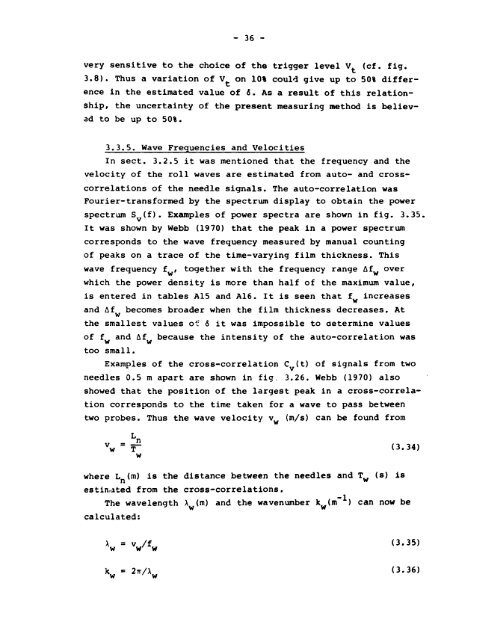An Experimental and Theoretical £ Investigation of Annular Steam ...
An Experimental and Theoretical £ Investigation of Annular Steam ...
An Experimental and Theoretical £ Investigation of Annular Steam ...
Create successful ePaper yourself
Turn your PDF publications into a flip-book with our unique Google optimized e-Paper software.
- 36 -<br />
very sensitive to the choice <strong>of</strong> the trigger level V. (cf. fig.<br />
3.8). Thus a variation <strong>of</strong> V on 10% could give up to 50% difference<br />
in the estimated value <strong>of</strong> 6. As a result <strong>of</strong> this relationship,<br />
the uncertainty <strong>of</strong> the present measuring method is believed<br />
to be up to 50%.<br />
3.3.5. Wave Frequencies <strong>and</strong> Velocities<br />
In sect. 3.2.5 it was mentioned that the frequency <strong>and</strong> the<br />
velocity <strong>of</strong> the roll waves are estimated from auto- <strong>and</strong> crosscorrelations<br />
<strong>of</strong> the needle signals. The auto-correlation was<br />
Fourier-transformed by the spectrum display to obtain the power<br />
spectrum S (f) . Examples <strong>of</strong> power spectra are shown in fig. 3.35.<br />
It was shown by Webb (1970) that the peak in a power spectrum<br />
corresponds to the wave frequency measured by manual counting<br />
<strong>of</strong> peaks on a trace <strong>of</strong> the time-varying film thickness. This<br />
wave frequency f , together with the frequency range Af over<br />
which the power density is more than half <strong>of</strong> the maximum value,<br />
is entered in tables A15 <strong>and</strong> A16. It is seen that f.. increases<br />
w<br />
<strong>and</strong> Af<br />
w<br />
becomes broader when the film thickness decreases. At<br />
the smallest values o' : 6 it was impossible to determine values<br />
<strong>of</strong> f <strong>and</strong> Af because the intensity <strong>of</strong> the auto-correlation was<br />
w w •*<br />
too small.<br />
Examples <strong>of</strong> the cross-correlation C (t) <strong>of</strong> signals from two<br />
needles 0.5 m apart are shown in fig. 3.26. Webb (1970) also<br />
showed that the position <strong>of</strong> the largest peak in a cross-correlation<br />
corresponds to the time taken for a wave to pass between<br />
two probes. Thus the wave velocity v (m/s) can be found from<br />
L n<br />
v<br />
w = f~ (3.34)<br />
w<br />
where L<br />
n<br />
(m) is the distance between the needles <strong>and</strong> T,.<br />
w<br />
(s) is<br />
estin.^ted from the cross-correlations.<br />
The wavelength A (m) <strong>and</strong> the wavenumber k (m~ ) can now be<br />
yf<br />
w<br />
calculated:<br />
X = v /f (3.35)<br />
W W W<br />
K - 2 "/*w<br />
(3.36)
















